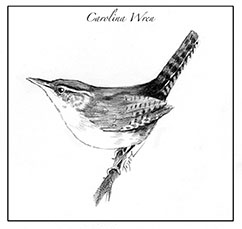By Susan Shea
I saw a new bird at my feeder last winter. In mid-December, a small, reddish-brown bird with an upturned tail, a white eyebrow-stripe, and a long, slender, down curved bill was on the deck below our feeder. Looking at its cocked tail, I suspected it was a type of wren — a Carolina wren, I discovered upon checking my field guide. I had heard the rich, whistled song of this wren in my neighborhood for the first time the previous summer, but this was the first time I’d seen one.
The bird hopped over to the sliding glass door I stood behind and peered up at me, seemingly just as curious about me as I was about it. It had a white throat, buffy-orange underparts, and barring on its wings and tail. What a striking little bird! But what, I wondered, was the state bird of South Carolina doing in central Vermont in winter?

Carolina wrens have gradually expanded their range northward over the past 125 years or so. Bird guides now show their core range extending from Mexico and Texas, across the Southeast and Midwest, north to Chicago, and east to Boston. Birders have also reported sightings on eBird during all months of the year around northern New England. These sightings are concentrated in warmer areas such as the Connecticut River Valley, the Champlain Valley, and the coasts of New Hampshire and southern Maine. According to Kent McFarland, conservation biologist with the Vermont Center for Ecostudies, Carolina wrens have steadily gained in abundance in Vermont and moved northward in the state over the past 30 years.
Climate warming and the proliferation of backyard bird feeders have enabled these feisty, non-migratory wrens to make their homes farther north. However, severe winters with lots of snow and ice that cover ground feeding areas can drastically reduce local populations. For example, the Vermont Breeding Bird alas shows that the exceedingly snowy winter of 1976-77 eliminated most Carolina wrens from the state. The winter of 2014-15, with its deep snows, devastated the Massachusetts population. But this resilient species usually recovers within a few years.
Carolina wrens rely on dense shrub cover for nesting, foraging, and protection from predators, and prefer moist, forested ravines and bottomland woods with tangles of vines. These birds also do well in suburban areas where there are bird feeders and brushy vegetation. More than 90%of their year-round diet is animal matter, and natural foods include insects, spiders, seeds, nuts, berries, and occasionally small lizards, frogs, and snakes.
A study in Michigan by Jacob Job and Peter Bednekoff found that Carolina wren populations are limited more by food supply than temperature, and that feeders play a crucial role for this species in northern winters when food is scarce or covered by snow. At feeders, these wrens prefer suet, peanut hearts, hulled sunflower seeds, and mealworms. One peanut can provide more than a third of a wren’s daily metabolic need.
These wrens forage primarily on or near the ground, turning over leaf litter with their bills, flitting through low thickets, and hopping up tree trunks and along branches to probe for insects in bark crevices. McFarland has seen them hunting in his compost pile. In his “Life Histories of Familiar North American Birds,” author and ornithologist Arthur Cleveland Bent described the Carolina wren as “the embodiment of tireless energy and activity, seldom still for a moment as he dodges in and out of the underbrush or creeps over and around a pile of logs.”
These wrens are early nesters, constructing their bulky, dome-shaped nests with a side entrance as soon as early to mid-April. The pair builds several nests before choosing one to use; dummy nests are believed to confuse predators. In woodlands, Carolina wrens nest in cavities and stumps three to six feet off the ground. Around homes, they will nest in a wide variety of places: birdhouses, mailboxes, garages, firewood piles, hanging plants, and empty flower pots. Their nests have even been found in old boots and in the pocket of an old coat. During breeding season, wrens defend their territory by constant singing and by scolding and chasing intruders.
A pair of Carolina wrens nested in a hole in my neighbors’ stone wall last summer, and perhaps I will see those birds at my feeder this winter. Look for this charismatic wren at your feeder, and listen for its piercing song in early spring: “tea-kettle, tea-kettle, tea-kettle-tea.”
Susan Shea is a naturalist, writer, and conservationist based in Vermont. Illustration by Adelaide Murphy Tyrol. The Outside Story is assigned and edited by Northern Woodlands magazine and sponsored by the Wellborn Ecology Fund of the New Hampshire Charitable Foundation: nhcf.org.



